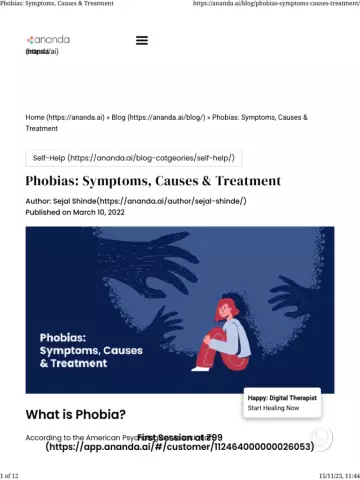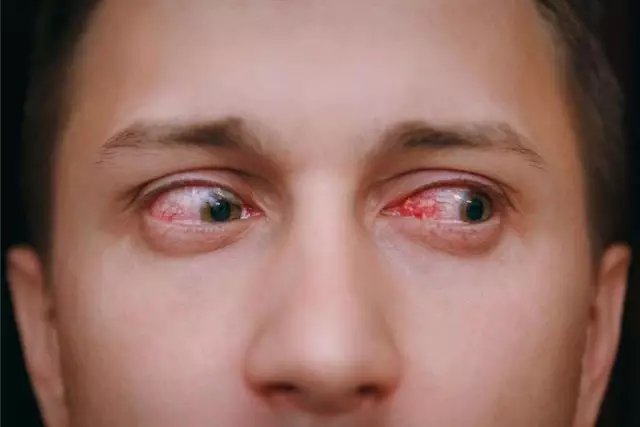- Author Rachel Wainwright [email protected].
- Public 2023-12-15 07:39.
- Last modified 2025-11-02 20:14.
Epidermophytosis
Brief description of the disease

Epidermophytosis is a disease characterized by damage to the upper layers of the skin and nails by fungi of the genus epidermophyton. Epidermophytosis refers to a number of fungal skin diseases. It is more common in men, although epidermophytosis in women is also not uncommon.
There are two forms of epidermophytosis: epidermophytosis inguinal and athlete's foot.
Epidermophytosis inguinal
Epidermophytosis inguinal - caused by the fungus Epidermophyton inguinale Sabourand. You can get infected with this disease in a bath or a swimming pool, using common washcloths, towels, and personal hygiene items.
A favorable environment for the causative agent of epidermophytosis inguinal is heat and moisture, therefore, most often this disease affects overweight people with a tendency to increased sweating, diabetes patients. Frequent use of wet compresses can also contribute to the development of the disease. There is epidermophytosis inguinal in women and men, although males are more often sick.
Localization of the disease - on the inner thigh, in the groin folds, on the pubis and armpits. In obese people, epidermophytosis can spread to the skin of the chest or abdomen. Epidermophytosis in women also occurs on the skin under the mammary glands.
The initial stage of the disease is characterized by the appearance of red spots that flake off. Later, large lesions appear with redness and a swollen edge, blisters and scales may appear in these places. With the development of the disease, the foci merge into large affected areas. The wound edges are composed of exfoliated epidermis. During periods of exacerbation, itching is a characteristic symptom of the disease.
Inguinal epidermophytosis begins acutely, but then takes on a chronic form and can last for months or even years. Periods of remission alternate with periods of exacerbation.
Epidermophytosis of the feet
Epidermophytosis of the feet is a contagious disease that is transmitted from person to person when visiting a bath, pool, showers, on the beach. Walking on infected rugs or mats with bare feet, wearing someone else's shoes, socks can also provoke athlete's foot. The development of the disease is facilitated by increased sweating of the legs, wearing tight, improperly fitted shoes, various abrasions and diaper rash, and a violation of the acid-base balance of sweat. Also epidermophytosis of the feet can occur as a result of general diseases: disruption of the normal functioning of the nervous and endocrine systems, hypovitaminosis, angioipathy, foot injuries, acrocyanosis.
The causative agent of the disease is the fungus Trichophyton mentagrophytes.
There are several forms of this disease.
Squamous form - characterized by the presence of peeling on the arches of the feet, which can occupy small areas or spread over the entire foot. Patients are worried about minor itching, sometimes symptoms may be completely absent. Therefore, this form of the disease often goes unnoticed, which worsens the epidemiological situation. At the initial stage, only one foot is affected, then the disease extends to the second foot.
Intertriginous form - occurs when there is a squamous form. Localization of the pathogen is in the interdigital space, most often between the fourth and fifth toes. This form of epidermophytosis is characterized by the presence of cracks, which are surrounded by exfoliating epidermis, between the toes. Sometimes the disease can spread to the folds of the fingers and foot. The intertriginous form is characterized by itching and soreness of the affected areas. The disease has a long course, exacerbation occurs in winter. In the absence of treatment, it is possible to develop chronic erysipelas of the legs and thrombophlebitis due to the addition of streptococcal infection.
Dyshidrotic form - characterized by the presence of bubbles on the arches of the foot, different in size. The bubbles can coalesce and form ulcerative surfaces with exfoliated epidermis along the edges. The disease can spread to the inner and outer lateral surfaces of the feet. The symptoms of the disease are soreness and itching. If an infection gets to the affected area, then the liquid in the bubbles becomes cloudy, pus is released. Development of lymphangitis and lymphadenitis is possible. The disease is characterized by a long course with periods of remission and exacerbation.
Epidermophytosis of nails is one of the forms of epidermophytosis of the feet. At the initial stage of the disease, yellow stripes or spots form on the nail edge. Then the nail plate thickens, becomes yellow. With the development of epidermophytosis of the nails, the destruction of the nail plate is observed, as a result of which it crumbles and breaks. Sometimes, with epidermophytosis of the nails, the nail plate becomes thinner and rejected. This process is also called onycholysis. Most often, the fungus affects the first and fifth toes.
Epidermophytosis treatment
Treatment of epidermophytosis is aimed at getting rid of the causative agent of the disease.

Inguinal epidermophytosis - treatment involves the use of drugs such as: mycosolone, sulfur-tar ointments, 2% iodine tincture, lorinden-C.
If the disease is localized on the feet, then the treatment of epidermophytosis involves the appointment of fungicidal preparations, such as sulfur-tar ointments, mycoseptin, mycozolone, Wilkinson's ointment, Castellani's fluid, etc. Also, detachment is carried out according to Arievich and Sheklakov.
YouTube video related to the article:
The information is generalized and provided for informational purposes only. At the first sign of illness, see your doctor. Self-medication is hazardous to health!






